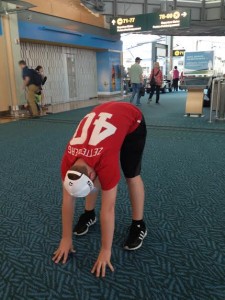You Get to go Traveling!
Lucky, lucky you! I love and totally believe the saying, “travel is the only thing you can spend money on and be richer for”!
So, I am just curious if you want to start your vacation feeling stiff and sore? If so, DO NOT do any of the following things… ; )
1. Think about your pre-trip routine – You want to start your travelling as limber as possible so, if available, before you leave for the airport get in a workout or power walk to get the blood flowing and joints lubricated. Have a few glasses of water to keep discs imbibed and tissues hydrated.
2. Find a place to stretch as you are waiting to board – The stiffer you go onto the plane, the stiffer you will be after sitting for 2 or 14 hours. Please help me not be the only weird one at the gate and find a corner to get your hips, legs, back and shoulders stretched out. I would LOVE if airports or airlines offered a stretching area…maybe if there was an official space to stretch people wouldn’t feel as self conscious (and we won’t be disowned by our teenagers). It seems like an inexpensive way for airlines to increase the comfort and thus happiness and loyalty of their customers. Till then, look for me going through some sun salutations off in the corner, trying to look as inconspicuous as possible.
3. Stay mindful about how you are sitting on the plane – The more our body is collapsed, the more will be loaded on the joints of our low back and the more stress will be through our flexed upper back due to the rounding created and our forward heads (heads weigh an extra 10 pounds for every inch it sits forward). So try this to prevent collapsing…pretend you still have a tail off your tail bone and do not sit on it; instead, flick it behind you and sit on your sit bones. If the airplane seat has a lumbar support, it is easier to maintain this healthy posture – if not ask for a little pillow or roll up your sweatshirt to help maintain the lumbar curve. Once this is addressed the upper back will effortlessly be more straight and the head supported by the spine (not your upper back and neck muscles). Now partway into the flight, if you are like me, your “tail” will be back underneath you so just reset and continue to remind yourself through out the flight.
4. Try to change your position often – The most obvious change of position is to stand when it is safe and the captain has turned off the seatbelt sign. But subtle changes can be helpful too…if your legs are crossed, switch the leg on top or get your hips stretched out by crossing just your ankle over the opposite knee and lean forward, then of course switch legs. If you are on the right of your family member or friend and turning left to chat, switch seats half way through the flight to also spend time in right rotation. Should you get in a nap with your head resting to the right, for your next nap rest it to the left.
5. Keep electronics at eye level – Use the food table to hold laptops and iPads, not your lap, so the screen is closer to eye level and your head can remain more neutral (remember those extra 10 pounds per inch forward?).
6. Do simple mobility exercise while seated, during the flight – There are many simple mobility exercises that you can be done in your seat without annoying your neighbour: backward shoulder rotations, simple side to side neck stretches, ankle rotations, that hip stretch mentioned earlier and forearm stretches, especially if you are typing on your laptop or iPad.
After months of saving for and planning your great trip, really, the last thing you want is to be uncomfortable while you are away and have a sore back limit your ability to see and do all you have planned. I hope these tips serve you and help you get the most out of all the exciting adventures that await you!

